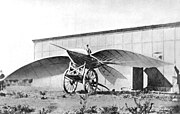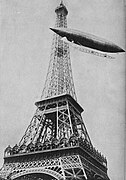Portal:Aviation
| Main page | Categories & Main topics |
|
Tasks and Projects |

Aviation includes the activities surrounding mechanical flight and the aircraft industry. Aircraft includes fixed-wing and rotary-wing types, morphable wings, wing-less lifting bodies, as well as lighter-than-air aircraft such as hot air balloons and airships.
Aviation began in the 18th century with the development of the hot air balloon, an apparatus capable of atmospheric displacement through buoyancy. Some of the most significant advancements in aviation technology came with the controlled gliding flying of Otto Lilienthal in 1896; then a large step in significance came with the construction of the first powered airplane by the Wright brothers in the early 1900s. Since that time, aviation has been technologically revolutionized by the introduction of the jet which permitted a major form of transport throughout the world. (Full article...)

... that Paul Haenlein was the first to create a dirigible airship powered by an internal combustion engine? ...that Frenchman Jean-Marie Le Bris accomplished the world's first powered flight in 1856, with a glider that was pulled behind a running horse? ... that 820 Naval Air Squadron was involved in attacks on the German battleships Bismarck and Tirpitz during the Second World War?
- May 29: Austrian Airlines cancels Moscow-bound flight after Russia refuses a reroute outside Belarusian airspace
- August 8: Passenger flight crashes upon landing at Calicut airport in India
- June 4: Power firm helicopter strikes cables, crashes near Fairfield, California
- January 29: Former basketball player Kobe Bryant dies in helicopter crash, aged 41
- January 13: Iran admits downing Ukrainian jet, cites 'human error'
- January 10: Fire erupts in parking structure at Sola Airport, Norway
- October 27: US announces restrictions on flying to Cuba
- October 3: World War II era plane crashes in Connecticut, US, killing at least seven
- September 10: Nevada prop plane crash near Las Vegas leaves two dead, three injured
- August 6: French inventor Franky Zapata successfully crosses English Channel on jet-powered hoverboard
The following Wikimedia Foundation sister projects provide more on this subject:
-
Commons
Free media repository -
Wikibooks
Free textbooks and manuals -
Wikidata
Free knowledge base -
Wikinews
Free-content news -
Wikiquote
Collection of quotations -
Wikisource
Free-content library -
Wikiversity
Free learning tools -
Wikivoyage
Free travel guide -
Wiktionary
Dictionary and thesaurus
Ballooning was a risky business for the pioneers. Blanchard lost consciousness on a few occasions, endured freezing temperatures and almost drowned when her balloon crashed in a marsh. In 1819, she became the first woman to be killed in an aviation accident when, during an exhibition in the Tivoli Gardens in Paris, she launched fireworks that ignited the gas in her balloon. Her craft crashed on the roof of a house and she fell to her death. She is commonly referred to as Madame Blanchard and is also known by many combinations of her maiden and married names, including Madeleine-Sophie Blanchard, Marie Madeleine-Sophie Blanchard, Marie Sophie Armant and Madeleine-Sophie Armant Blanchard.

The Avro Lancaster was a British four-engine Second World War bomber aircraft made initially by Avro for the British Royal Air Force (RAF). It first saw active service in 1942, and together with the Handley-Page Halifax it was one of the main heavy bombers of the RAF, the RCAF and squadrons from other Commonwealth and European countries serving within RAF Bomber Command. The "Lanc" or "Lankie," as it became affectionately known, became the most famous and most successful of the Second World War night bombers, "delivering 608,612 tons of bombs in 156,000 sorties." Although the Lancaster was primarily a night bomber, it excelled in many other roles including daylight precision bombing, and gained worldwide renown as the "Dam Buster" used in the 1943 Operation Chastise raids on Germany's Ruhr Valley dams.
- Span: 102 ft (31.09 m)
- Length: 69 ft 5 in (21.18 m)
- Height: 19 ft 7 in (5.97 m)
- Engines: 4× Rolls-Royce Merlin XX V12 engines, 1,280 hp (954 kW) each
- Maximum Speed: 240 knots (280 mph, 450 km/h) at 15,000 ft (5,600 m)
- First Flight: 8 January 1941
- Number built: 7,377
- 2012 – a Yemeni Air Force Antonov An-26, a twin-engine turboprop military transport aircraft, crashed in Sana’a, Yemen’s capital, resulting in the deaths of all ten individuals on board, including five military officers.
- 2012 – A ceasefire brings fighting in the Gaza Strip between Israel and Hamas to an end.
- 2012 – JetBlue Flight 1329: An Embraer E190, taxis to its gate after landing at Baltimore-Washington International Airport in Anne Arundel County, Maryland, a fire breaks out in one of its engines. After the airliner reaches its gate, everyone on board evacuates the plane uninjured via the jetway while firefighters douse the fire.
- 2004 – China Eastern Airlines Flight 5210, a Bombardier CRJ200, stalls and crashes near Baotou, China shortly after takeoff because of frost contamination; all 53 on board and two people on the ground are killed.
- 2003 – OH-58D Kiowa 92-0605 from D Troop, 1–17 Cavalry Regiment written off, reason unknown.
- 1990 – First flight of the Hongdu JL-8
- 1989 – A British Airways Boeing 747 narrowly misses crashing into the Penta hotel near Heathrow Airport
- 1986 – The first ever RAF air-to-air refuelling of a fully-loaded passenger carrying transport aircraft. It was carried out on a trooper flight to Oman as part of Exercise Saif Sareea. The refuelling took place over Sicily as part of the 4,200 mile, 9 h flight.
- 1981 – Aeroflot is banned from flying to the United States, after an earlier Aeroflot flight that overflew American military installations, straying from its supposed flight path.
- 1980 – Continental Micronesia Flight 614, a Boeing 727, crashes on landing at Yap International Airport; all on board survive.
- 1970 – US aircraft begin the first major bombing campaign of North Vietnam since 1968. 300 aircraft attack the Mu Gia and Ban Gari passes.
- 1959 – Ariana Afghan Airlines Flight 202, a Douglas DC-4, crashes after an apparent in-flight fire, killing 24 of 27 on board.
- 1958 – Fairey Gannet AS.1, WN345, fitted with Armstrong Siddeley ASMD.8 Double Mamba 112 coupled turboprop powerplant, suffers belly landing this date during test programme, caused by a partially retracted nosewheel. The pilot tries unsuccessfully to get the gear to deploy. Lands gear-up on foam-covered runway 22 at Bitteswell, suffering minimal damage. Repaired, it is back in the air within weeks.
- 1952 – First flight of the Percival Pembroke
- 1948 – The Roundel, the RCAF service publication, made its first appearance.
- 1947 – First flight of the Grumman F9F Panther
- 1917 – 21-24 – The Zeppelin LZ-104 "Das Afrika-Schiff" makes a 6,757 km journey through Africa in 96 hours (average speed 71 km/h).
- 1914 – Three RNAS Avro 504s bomb the Zeppelin sheds at Friedrichshafen.
- 1783 – In a flight lasting 25 min, de Rozier and d'Arlandes take the first untethered ride in a Montgolfière in Paris, the first human passengers carried in free flight by a hot-air balloon.
References
- Shortcuts to this page: Portal:Airplanes • P:AVIA





















































